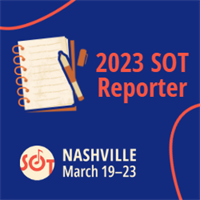
The Workshop Session “Challenges and Future Directions in NAM Applications to Mixtures Risk Assessment” discussed some of the most pressing challenges facing new approach methodologies (NAMs), particularly with mixtures. Chair David Hines (RTI International) opened the Workshop by posing a few questions:
- How can NAMs be most useful for informing mixture risk assessment?
- What are the current challenges in applying NAMs in regulatory settings?
- How can we progress toward the application of NAMs in regulatory settings for mixtures?
A US FDA/CDER Perspective
Amy Avila (US FDA/CDER) presented “A US FDA/CDER Perspective on Nonclinical Testing Strategies: Classical Toxicology Approaches and NAMs.” From a regulator’s view, NAMs have great potential to improve regulatory efficiency, expediate drug development, and answer unmet needs. These in vitro, in chemico, in silico, and, in some cases, in vivo methods can improve predictivity and help replace, reduce, and refine animal use. However, there are still gaps with using NAMs for nonclinical safety assessments—for example in improving the risk identification for rare toxicities, such as immune-mediated or central nervous system toxicity. In particular, there is a need to develop NAMs for assessing human skin sensitization of mixtures. While NAMs may be qualified and validated for individual compounds, a NAM also will need to be shown to be valid for mixtures in order to be useful for mixture risk assessment.
A European Perspective
Next, Stephanie Bopp (European Commission Joint Research Centre) described the “Advantages and Challenges of NAMs in Regulatory Risk Assessment of Chemical Mixtures.” In the European regulatory approach to mixtures, intentional mixtures are mostly covered and addressed using a component-based approach, but unintentional mixtures are generally not covered (aside from pesticide residues in food). NAMs could greatly help in this regard by enabling faster testing and better grouping of chemicals based on mechanism or mode of action. NAMs also could improve our understanding of the combined effects of chemicals, such as mixture interactions and synergistic or antagonistic effects. Dr. Bopp described a few issues that arise when NAMs are introduced into chemical legislation. NAMs are sometimes not sufficiently validated or standardized, and there is a need to build confidence in NAMs by ensuring that NAMs are fit for purpose, are transparent, and undergo independent peer review.
Case Studies for NAMs in Mixtures Risk Assessment
George Daston (Procter & Gamble) closed out the Workshop talks with “Case Studies Using NAMs for Evaluation of Complex Mixtures.” He further highlighted the different kinds of mixtures that need evaluating, such as known, well-characterized mixtures (e.g., consumer products) and unknown mixtures or UVCB (e.g., crude oil or chemical mixtures from the 2023 Ohio train derailment). Dr. Daston used case studies of refined petroleum streams and botanicals to demonstrate how exposure-based approaches, partial analytical characterization, and biological activity measures can be informative in risk assessment for complex mixtures.
The Workshop ended with a panel discussion and Q&A that provided valuable insight into needs related to NAMs. Some highlights from the discussion:
- For regulatory use and acceptance, we need data on how NAMs, or a battery of NAMs, compare and correlate to the in vivo endpoints.
- We have great toxicological information on adverse effects and outcomes from decades of animal research, but we still need information on the quantitative relationships related to key events and molecular-initiating events.
This Workshop Session was chaired by David Hines (RTI International) and Cynthia Rider (NIEHS) and was endorsed by the SOT Regulatory and Safety Evaluation Specialty Section (RSESS), SOT In Vitro and Alternative Methods Specialty Section (IVAM), and SOT Mixtures Specialty Section.
This blog reports on the Workshop Session titled “Challenges and Future Directions in NAM Applications to Mixtures Risk Assessment” that was held during the 2023 SOT Annual Meeting and ToxExpo. An on-demand recording of this session is available for meeting registrants on the SOT Online Planner and SOT Event App.
This blog was prepared by an SOT Reporter and represents the views of the author. SOT Reporters are SOT members who volunteer to write about sessions and events in which they participate during the SOT Annual Meeting and ToxExpo. SOT does not propose or endorse any position by posting this article. If you are interested in participating in the SOT Reporter program in the future, please email SOT Headquarters.
#Communique:ScienceNews
#2023AnnualMeeting
#Communique:SOTNews
#SOTReporter